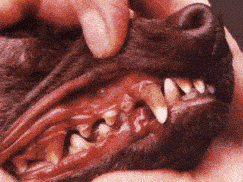What is Diabetes Mellitus?
In order to understand the problems involved in diabetes mellitus, it is necessary to understand something of the normal body’s metabolism.
The cells of the body require a sugar known as glucose for food and they depend on the bloodstream to bring glucose to them. They cannot, however, absorb and utilize glucose without a hormone known as insulin. This hormone, insulin, is produced by the pancreas. Insulin is like a key that unlocks the door to separate cells from the sugars in our bloodstream.
Glucose comes from the diet. When an animal goes without food, the body must break down fat, stored starches, and protein to supply calories for the hungry cells. Proteins and starches may be converted into glucose. Fat, however, requires different processing that can lead to the production of ketones rather than glucose. Ketones are another type of fuel that the body can use in a pinch but the detection of ketones indicates that something wrong is happening in the patient’s metabolism.
Ketones may therefore be detected in the urine of starving animals because of massive fat mobilization is required for ketone formation. Ketones can also be detected in diabetic ketoacidosis, a severe complication of unregulated diabetes so it is helpful to periodically monitor for ketones in a diabetic patient’s urine. The point is, for now, that in times of extreme fat burning (such as in starvation), ketones are a byproduct.
Ketones in urine for three days or more in a row warrants a visit to the veterinarian.
In a diabetic animal there isn’t enough insulin
- The cells cannot receive glucose from the blood because there is no insulin to permit

The pancreas is nestled along the stomach and small intestine. It secretes digestive enzymes into the small intestine but it also secretes hormones into the bloodstream to regulate blood sugar. it.
- The body is unable to detect the glucose in the blood and is fooled into thinking it is starving.
- Protein, starch, and fat break-down occur as they do in starvation.
- Yet all along there has been plenty of glucose in the blood. In fact, by now, there is a large excess of glucose as all resources have been mobilized. Still, without insulin, this bounty of fuel cannot get to the tissues that need it.
- The normal kidney is able to prevent glucose loss in urine. In a diabetic animal, there is so much glucose in the blood that the kidney is overwhelmed and glucose spills into the urine and is lost.
- Glucose is able to draw water with it into the urine. This leads to excess urine production and excess thirst to keep up with the fluid loss.
Thus the main clinical signs of diabetes mellitus are:
- Excessive eating
- Excessive drinking
- Excessive urination
- Weight loss
It is usually fairly clear from the history and tests showing dramatic glucose elevations in the blood (and usually glucose in the urine, too) that diabetes mellitus is the diagnosis. Some pets are able to substantially raise their blood sugars from stress (such as might occur when a sensitive, sick, and anxious patient goes the vet’s office).
This could create misleading test results. If there is any question about the diagnosis, a test called a fructosamine level may be requested. This test reflects an average blood glucose level over the past several weeks so if this is also elevated, a one-time elevated glucose can be distinguished from the persistent elevations of true diabetes mellitus. The fructosamine test is also sometimes used in monitoring therapy for diabetes mellitus.
In dogs, sugars can enter the lens of the eye causing rapid cataract formation. Because a cat’s lens is different, this phenomenon primarily occurs in dogs.
Another common symptom of diabetes mellitus is urinary tract infection. All the sugar in the urine makes the bladder an excellent incubator for bacteria. Antibiotics are necessary to clear up such an infection and some monitoring may be needed to help detect these infections.
Type I and Type II Diabetes Mellitus
What Happens Once a Diagnosis Is Reached
First, an insulin type and dose will need to be selected. There are several types of insulins and it is not possible to know how much insulin your individual pet will require. Your veterinarian can make a guess based on what works for other cats and dogs and what has been reported in the literature. Most pets require injections twice a day, approximately 12 hours apart, following a meal.
You will need to learn how to give insulin injections to your pet. The technique of subcutaneous (under the skin) insulin administration should be thoroughly demonstrated by your doctor or an assistant. You may be surprised to find that the most common reason for a pet having difficulty achieving regulation is that the owner is not giving the injections properly. Be sure you know how to hold the bottle, manipulate the syringe, hold your pet, and give the injection.
Some insulins are available from the neighborhood pharmacy and some kinds are available only through veterinary offices and pharmacies. You will need syringes and a bottle of insulin to begin home treatment. Your veterinarian will either provide you with supplies or will give you the necessary prescriptions. Insulin syringes are marked in insulin units so the insulin syringes must match the insulin concentrations (either U-100 syringes for 100 unit/cc insulins or U-40 syringes for 40 unit/cc insulins.) Always double check these numbers whenever you receive more supplies.
Never alter the insulin dose recommended by your doctor. To determine whether dose adjustments are needed (or if a different type of insulin is more appropriate), your pet will need a glucose curve where blood sugar levels are monitored every 2 to 4 hours or so for 12 to 24 hours. This kind of testing tells the doctor how long the insulin injection is lasting as well as what the lowest and highest glucose levels of the day are. It is important to find out when your pet’s curve is due. Often in the beginning, it takes several dose selections and several curves before the right dose is determined.
What about Home Glucose Testing?
Not every pet is amenable to getting pricked with a lancet so that a drop of blood can be harvested for testing. We do not want your pet to fear interaction with you and do not want you to get bitten or scratched; still, some pets are comfortable with periodic glucose monitoring at home. Home testing may work best for pets that become so agitated by going to the vet that their blood sugar levels are altered at the office and cannot be interpreted. Further, a pet owner can save a great of deal of money if they can produce their own glucose curve at home when the veterinarian requests one.
Human glucose meters can be obtained from any drugstore but ideally the AlphaTrak glucometer should be used as it is designed for pets. The AlphaTrak is more accurate in cats and dogs than the human equipment, although certainly the human equipment was all that was available for decades and worked sufficiently. If you would like to get an AlphaTrak meter, contact your veterinarian.
Sugarcats.net has put together an extensive review of equipment needed for home monitoring as well as picture guides for testing both dogs and cats.
If you choose to use a glucometer at home, be sure to keep a log of when your pet was fed, when insulin was given, and what the glucose levels were that you found. Bring this log to your veterinarian when you come for checkups. Glucose levels obtained prior to the first insulin administration of the day are particularly useful. Your veterinarian will also be particularly interested in signs associated with poor regulation: excessive thirst, excessive urine production, excessive appetite, and weight loss.
If your pet is too sensitive for a valid glucose curve at the vet’s office and you do not think you are up to blood sugar testing at home, the fructosamine blood test may be particularly useful. Again, this test looks at average glucose levels so wide fluctuations will not be discovered but at least there is a monitoring option for this situation.
Ketostix are used to detect ketones in urine and can be obtained at any drug store. If it is not difficult to access your pet’s urine, a first morning test is helpful. Remember, finding ketones occasionally is not a problem but a positive dipstick three days in a row is a criterion for a vet visit.
When to Return to the Hospital/What to Watch for
Your pet will probably require re-regulation at some point. During re-regulation periods, expect a curve to be run a week or two after each adjustment in insulin dose.
Bring your pet in for a re-check exam and glucose curve if your pet:
- seems to feel ill
- is losing weight
- has a ravenous appetite or loses its appetite
- seems to be drinking or urinating excessively
- becomes disoriented or groggy
- has ketones in the urine for three days in a row.
Annual Dental
It is important for diabetic pets to have their teeth cleaned annually. Dental tartar seeds  the body with bacteria and when blood sugar levels run high, infections in important organs can take root. The kidneys and heart are particularly vulnerable.
the body with bacteria and when blood sugar levels run high, infections in important organs can take root. The kidneys and heart are particularly vulnerable.
If your pet appears wobbly or drunken, the blood sugar level may have dropped too low. This occurs after an insulin overdose. First try to get your pet to eat. If the pet will not eat, administer light Karo syrup, honey, or even sugar-water at a dose of one tablespoon per 5 pounds. If no improvement occurs, immediately see your veterinarian for emergency treatment. When your pet is more stable, a glucose curve will be needed to determine why this happened and what a more appropriate insulin dose might be.
Urban Animal Veterinary Hospital
1327 Yale St
Houston, TX 77008
(713) 863-008


